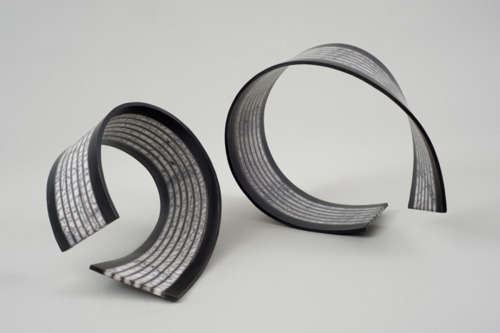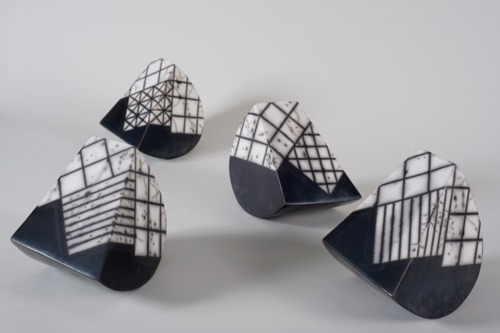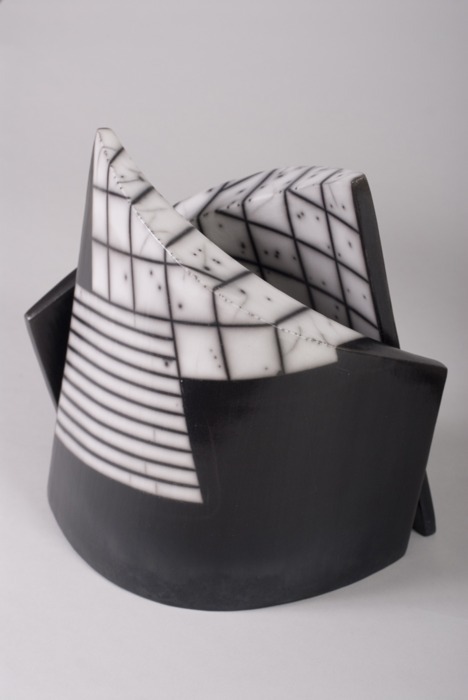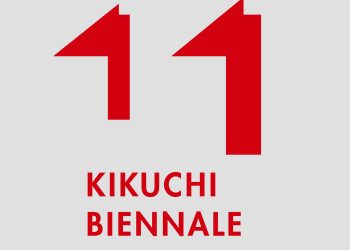
We know that you are a successful ceramic artist and also a scientist. How do you find time and motivation for both of your jobs?
Science is a continuous stimulus for me; it has broadened my creativity thinking; it has pushed me to experiment and taught me that patience and perseverance lead to improved results. Art and science are integral parts of my life; although following both careers involved hard work (nights and weekends are dedicated to ceramics). I’m not preparing to give up one or the other. My analytical mind is well attuned to intuitive and creative possibilities; they successfully combine and complement each other.
Your works are investigating the elements of ambiguity and dynamic of opposites, or by other means, they try to mislead the viewer. Can you tell us more about this?
I have always been fascinated by the elusive harmonies created when a precise, controlled architectural element is brought together with intricate surface designs and colors to generate the complete object and induce an aesthetic as well as intellectual stimulus. My body of work deals with the construction of architectural geometrical shapes, their fragmentation, and the rapport generated when they are combined to form an assemblage. The use of the geometric design on the surface adds another dimension to each object on it own, but also has an impact on the fractures between objects in a group, as the flow of lines and shapes redefines the significance of each shape and gives a visual perception of unity and harmony to the work. The division of the body surface between white and black as well as the use of lines softens the shape. Placing the grid or lines on the edge of the shape, so that the shape flows, completely dissolves the hard lines. Viewed from different angles, surface and volume are blurred, giving an illusion of flatness.
While the black sculptures may seem massive and heavy, their weight is light when actually lifted. Their stance appears fragile when placed on their convex side, but they are full of energy and movement. Once again, the duality of heavy-light, stability versus instability, negative and positive shapes, produce contrast between appearance and reality.
I am starting on a new line of works dealing with balance, flow and motion. A dialogue between the inside and the outside of the object exists in each work creating flow motion in addition to the dialogue between the objects that developed through the way the objects are placed.

Rhytmus – View her works
When did you start using the naked raku firing technique. Tell us about your first experience and how it evolved in time.
I started to use Naked Raku technique six years ago. Since I established my studio (1996), I used a number of techniques before eventually finding my hallmark technique and unique look. Initially, I focused on wheel-thrown works and developed my own range of glazes, all being fired in an electric kiln. However, I reached a stage where the work no longer pleased me. I felt that I had nowhere further to go with it, and decided that I was no longer interested in the glaze surface. I then discovered the smoke-firing technique using metal salts and sawdust, and felt an immediate affinity for it. Here was a way to achieve a tactile surface of the depth and great richness, without glaze. I loved the soft quality created by smoke-firing and knew that I had at last found my path. I experimented with the relationship between the clean minimalistic shapes and the “storm” of surface colors (results from reduction and oxidation of metals salts used) generated by the uncontrolled spontaneous movement of firing.
After I had mastered this process sufficiently, I still felt that I have a limited ability to express my ideas. I needed to make some changes. I decided to stop the throwing method and began to make slab-built pieces and to use the Naked Raku technique to change the surface appearance. This combination of slab building and Naked Raku technique gave me more flexibility and ability to work on more complex relationships and express my ideas.

How do you make your works? There is an extremely complex process involved, which shows that you are very careful ceramist, and scientist.
Each piece is slab-built using a mixture of porcelain and stoneware. Then it is burnished, and when bone-dry, a thin layer of terra sigillata is applied. The piece is then bisque-fired to 1000 0C. The designed sketches are drawn to the bisque-fired objects and taped-over. At this point the Naked Raku begins. A layer of resist slip is applied, followed by an additional layer of the raku glaze. The resist slip creates a thin space between the clay and the glaze and prevents the glaze from melting onto the clay surface. Before firing, the applied tapes are removed, and the works are then fired in a raku gas kiln to 1000 0C before being removed to a smoke chamber. There the smoke penetrates the cracks of the outer glaze and continues through the resist-slip and into the clay; this will leave irregular crack-like patterns and spots on the work’s surface. The exposed areas (taped areas not covered with the resist-slip and glaze) are carbonized during the process and turn black. When cold, the glaze peels off, hence the term “naked”. This is followed by resist-slip washing, and when dry, a layer of wax is applied.

You are used to participating in a lot of international ceramic contests or biennales. What have you learned from these experiences? Do you encourage other artists to participate too?
Coming from a small country, it is especially important to me to broaden the scope of interaction and dialogue with other artists with different points of view and techniques and expose my work to them. Participating in different international ceramic competitions/biennales/exhibitions enables me to meet and personally different ceramic artists from different countries. Interaction with highly skilled colleagues always leads to improvement and progress.
Participation in international ceramic exhibitions enables international recognition.
Are you working on a project right now? Where can we find you and your works in the next future?
At the moment, I’m working on a new line of work dealing with balance, flow and motion, which I started a few months ago. For updates, please visit my website www.simcha-evenchen.com
Gallery and Museum Shops which exhibit and sell my works:
– NUMMER40 – Modern Art & Design Gallery – 2e Loolaan 40, 7009 AT, Doetinchen, Nederland http://www.nummer40.com
– Eretz-Israel Museum Gift Shop, Tel-Aviv, Israel
– Begin Heritage Center – Museum Shop, Jerusalem, Israel

How would you characterize the contemporary ceramic art scene in Israel?
As in the all world contemporary ceramic art in Israel is relatively limited. Since Israel is a small country, the possibilities to exhibit are accordingly small, and the ceramic community is unified.
There are only a few places where ceramic artists can exhibit their works in Israel. “Benyamini Contemporary Ceramic Center”, located in Tel-Aviv, is a new and important place. It was recently opened (June 2011). This center offers a variety of courses in the field of ceramic art. It has a library and a large space for ceramic exhibition. For more details see www.benyaminiceramics.org/en. Another place, active for many years, is “Kahana House”, located in Ramat-Gan. The only private design gallery which from time to time, exhibit ceramic is Periscope, located in Tel-Aviv.
Once in two years there is the Israeli Ceramic Artists Biennale, which is held in Eretz-Israel Museum in Tel-Aviv. Only the jury- selected artists can exhibit at this exhibition. This is the most important ceramic event in Israel.
There are several ceramic cooperatives: two in Tel-Aviv and four in Jerusalem. Each cooperative has 10-14 ceramic artists presenting their works.
Give advice for someone who just started doing ceramic art.
Create your own visual language!
Do a lot of research, concentrate and focus on what you are doing and avoid editing away ideas too early.
“In my recent works I use ceramic sculptures to investigate the elements of ambiguity and dynamic of opposites. Ambiguity is express by the contrast between appearance and reality. Looking at the precise shapes that enclose and contain space gives the impression of solid and massive bodies when they are in fact, surprisingly light and delicate.
The dynamic of opposite is express in a way that juxtaposes the precise and controlled building and graphic design of the ceramic work the unpredictable firing technique of “Naked Raku”.
In these works, I’m dealing with issues such as tensions between polarities, with fragmentation and constructions and with illusions. These concepts are guidelines for my treatment of space in the context of surface-volume relationships. The division of the body surface between white and black, as well as the use of lines softens the shape, simultaneously placing the grid or lines on the edge of the shape, so that they follow the shape, completely dissolve the hard lines. Viewing from different angles, surface and volume are blurred, giving an illusion of flatness.
This idea is strengthened and extended by working with pairs or creating a composition of a few units, where new volumes and planes are achieved by way of the lines or grid are virtually joined; the ratio of parts to the whole is changing and two and three dimensions are played against each other in a sophisticated manner.” Simcha Even-Chen
By Vasi Hirdo.
Published in Ceramics Now Magazine Issue 1.
View Simcha Even-Chen’s profile on Ceramics Now.
Visit Simcha Even-Chen’s website.



















